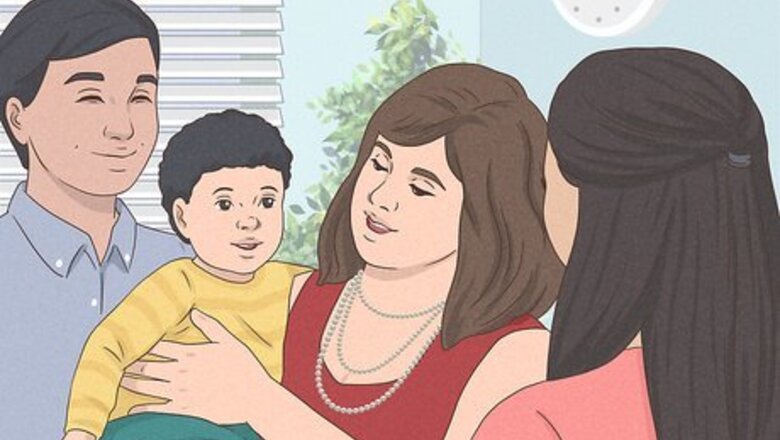
views
Creating a Safe Environment
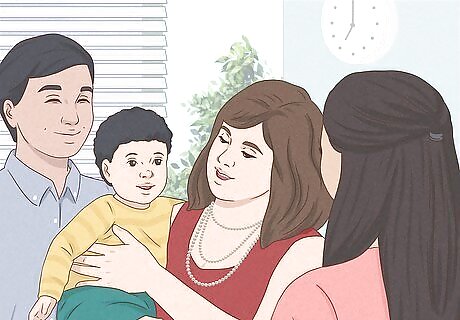
Arrive early. Get to the child's home 15 - 30 minutes before it is time for the parents to leave. Use this time to get instructions from the parents, discuss your responsibilities, and take a tour of the home. Also ask the parents about any house rules and about the child's routine. Ask about the child's eating schedule, bedtime, and preferred activities. Locate the first aid supplies and ask about any areas of the house that are off limits for the child. Ask if you are allowed to have visitors, use your cell phone, or use the television and computer. Make sure to write down any important information, such as phone numbers, the child’s bedtime, and when and what to feed the child.

Get the emergency information. Anything can happen while you are babysitting. It is important for you to easily be able to contact someone if something goes wrong. Get the name and phone number for the parents and another adult in case the parents are not available. Also write down the address where you are babysitting in case you need to call emergency services. In case the child swallows something poisonous, the number to the poison control center is 1-800-222-1222. This is a 24/7 number.
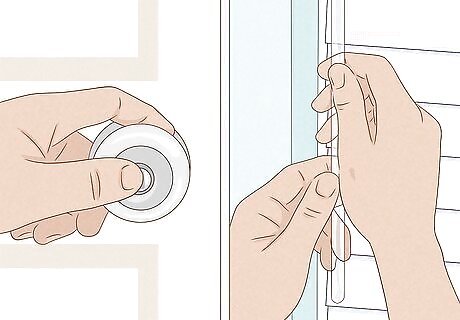
Secure the house. Once the parents leave, make sure you lock all of the doors and windows. You should also close all of the blinds, especially if you are babysitting at night. Close the doors to any areas that the child should not go in as well.
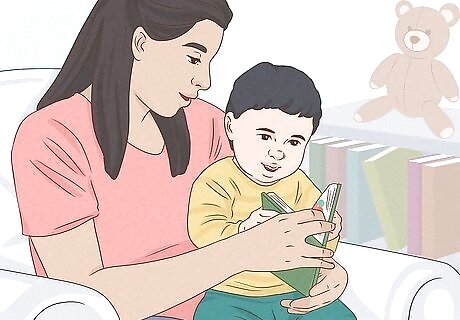
Play in safe areas. Toddlers are very active and anything can happen when you turn your back. Do not allow the child to play near closets, chests, medicine cabinets, or any storage locations. Check with the parents before you take the child outside to play. If the child is allowed to play outside, keep him or her away from traffic and in designated safe areas. Also keep the child away from stairs and electrical outlets. Make sure everything within the baby's reach is anchored down so they don't pull anything on top of themselves. Be aware of any small toy pieces or particles on the floor that the child may pick up and put in his or her mouth. Never take your eyes off of the child.
Taking Care of the Child

Know how to change a diaper. A 1-year-old will probably need a diaper change while you are babysitting. It is important that you change the child regularly so he or she does not get a diaper rash. Check the diaper before and after a nap or when the child eats. A wet diaper will likely feel heavy, and you will definitely be able to smell a poopy diaper. Gather all of your supplies (e.g. clean diaper, baby wipes, damp washcloth, dry washcloth, diaper ointment, changing pad) before you get started. Place the child on the changing table and remove the dirty diaper. Wipe the child from front to back with the damp washcloth or baby wipe. Pat the child dry with a clean, dry washcloth and put a thin layer of diaper ointment if the parents have asked you to. Open the new diaper, lift the child's legs, and slide the diaper under him or her. Place the front part of the diaper between the child's legs and onto his or her belly. Then fasten the adhesive strips from the back of the diaper to the front of the diaper. Wash your hands and the baby’s after you are finished changing the diaper. Never leave the child unattended on the changing table. A good rule is to always keep 1 hand on the baby while they are on the changing table.
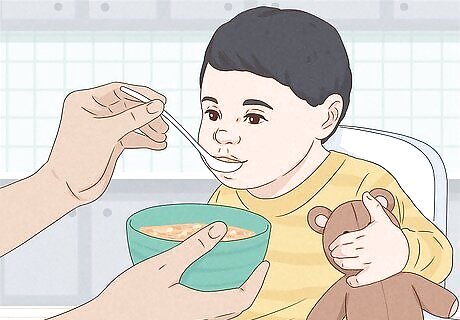
Feed the child. Ask the parents what kind of food the child likes to eat and how well the child can chew and feed him/herself. Most toddlers like finger foods that can be easily picked up, and they are not very good at using utensils yet. Cut the food into bite size pieces before giving it to the child. Make sure the child is sitting down during meal time. You do not want the child to choke. Most toddlers eat 3 meals a day and few snacks in between. Check with the parents to determine the child's feeding schedule. Also, make sure to ask if the child has any allergies. If the child has a severe allergy, find out where the parents keep the Epi-Pen and ask them to demonstrate how to use it in case of an emergency.
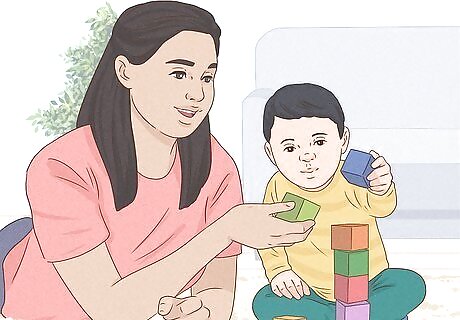
Engage in fun activities. Good activities for a 1-year-old include: building with and knocking down blocks, playing with soft stuffed animals, playing hide and seek, and playing with any toys that can be pushed or pulled (e.g. tool sets, telephones, dish sets). Children this age can also draw with large crayons. You may have to hold the paper down while the child draws. Ask the parents what the child's favorite toys and activities are. Whatever you play with the child, never take your eyes off of him or her. Children get bored easily, so you will probably have to do multiple activities while you are babysitting.
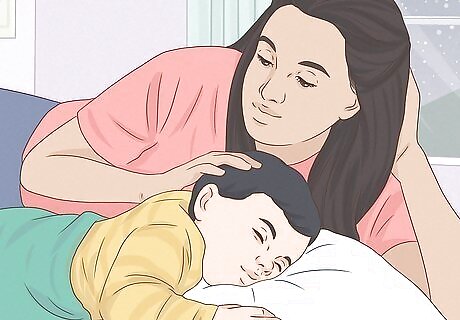
Put them to bed. Ask the parents the child's bedtime and usual nighttime routine. The child may not want to go to bed, but it is best to keep his or her typical schedule.. You may give the child some warm milk or read a story before putting the child to bed. Check on the child periodically while he or she is sleeping. Do not listen to the TV too loudly or talk on the phone just because the child is sleeping. You need to be able to hear if the child makes a noise or begins to cry. If the child begins to cry, wait a minute and see if he or she stops. If the crying does not stop, go check on the child. You may have to comfort and/or hold the child until he or she goes back to sleep. Check on the child every 30 minutes.

Bathe the child. Some parents may not be comfortable with you bathing the child. Check with the parents before they leave to make sure it is alright. Fill the bath tub with about four or five inches of lukewarm water. Apply a small amount of the child’s soap to the child's body and then rinse the child off. Use a washcloth to clean the child's face. Do not get soap in the child's face or eyes. Once you are finished, dry the child off, put on a fresh diaper, and dress the child. Make sure to ask the parent first if it is okay to bathe the child. Only use products that are meant for the child. Never leave the child alone in the tub. Never take your eyes off of them either! If the child has bath toys, allow him or her to play with them during bath time. Smile and talk to the child as you bathe him or her.
Handling Common Problems

Deal with a temper tantrum. Keeping the child occupied and happy can help prevent temper tantrums, but the child may have one anyways. If the 1-year-old throws a temper tantrum stay calm and never argue with the child. Children that age have a pretty short attention span, so distracting them with a toy or activity could stop the tantrum. If he or she is on the ground kicking and rolling around, try to keep the child safe and from damaging anything. Although it may be tempting, do not leave the child alone in a room during the tantrum. Once the tantrum is over, comfort and hold the child and try to engage the child with a fun activity.

Console a crying child. A 1-year-old may cry when his or her parents leave. This is normal, and the child will probably stop once he or she gets comfortable. Remind the child that his or parents will be coming back later and try to distract the child with a toy or a snack. Continue to stay calm and comfort the child. Your demeanor will help the child feel safe and comfortable.
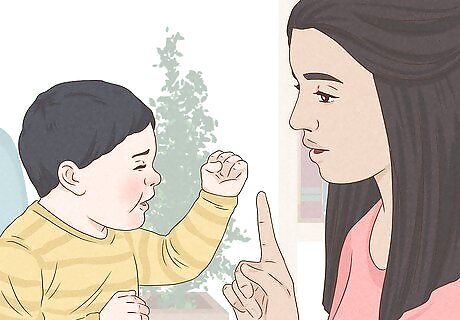
Stop a child from hitting you. Small children sometimes like to hit other people. If the 1-year old hits you, firmly tell the child to stop. Ask the child’s parents if they use time outs. If not, and if the child hits you, say to the child, “It is not okay to hit me.” Then, suggest something else for them to do with their hands, such as coloring or playing with some building blocks. If the child does not stop, let the parents know about the behavior when they return. Never hit or physically punish the child.

Talk to the parents. Once the parents return, give them a report of how the babysitting went. Tell them about meal time, diaper changes, and bedtime. Let them know the activities that you did with the child and the child's reaction to the different activities. It is important to be detailed because the child is unable to let the parents know how things with. Always be honest with the parents about how everything went.













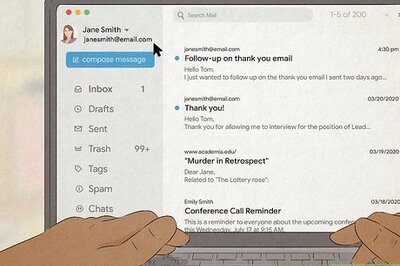


Comments
0 comment